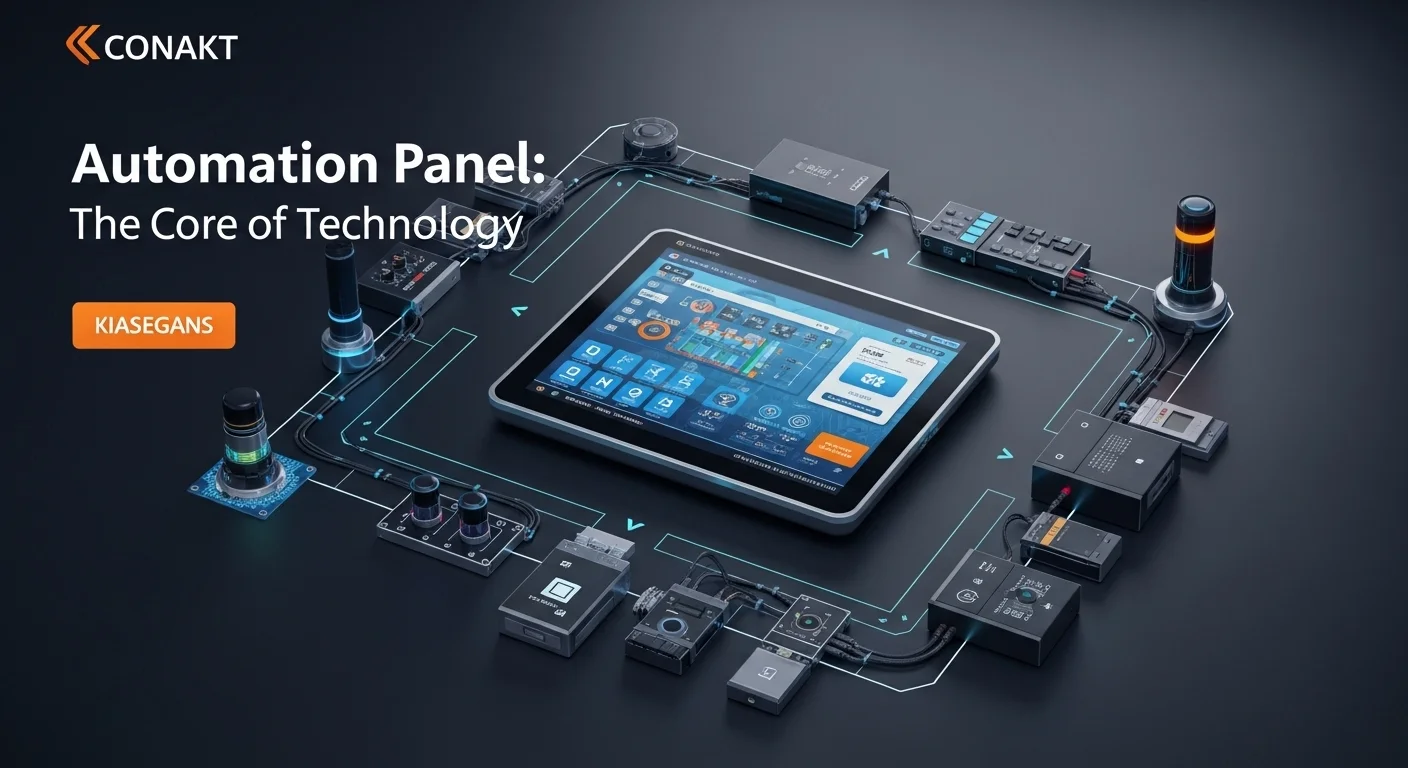Automation Panels: Your Smart Home and Business Command Center

Executive Summary
In my years working with smart technology, I've seen one thing become the true heart of any modern space: the automation panel. It’s the central nervous system that transforms a regular building into a responsive, intelligent environment. This isn't just about fancy gadgets; it's about simplifying your life and streamlining your business. In this guide, I'll walk you through everything you need to know, from my own experience. We'll look at the different kinds of panels you'll encounter, from the powerful 'brain' of the system (the control panel) and the sleek screen you interact with every day (the touch panel), to the game-changing smart electrical panels that manage your home's energy at its very source. For a business, this tech means smarter operations and real savings. For you at home, it's the ultimate upgrade in comfort and security. Let's pull back the curtain and see how these panels are fundamentally changing how we interact with our world.
Table of Contents
What is an Automation Panel, Really?
Let's forget the jargon for a second. Think of an automation panel as the conductor of an orchestra. Your lights, thermostat, security cameras, and speakers are all talented musicians, but without a conductor, they're just making noise. The automation panel brings them all together, allowing you to create a beautiful symphony of convenience with a single tap. I got my start in industrial settings, where these panels, called Human-Machine Interfaces (HMIs), were crucial for running massive factory floors safely and efficiently. Seeing a single person manage a complex production line from one screen was mind-blowing. Now, that same powerful concept has evolved and come right into our living rooms and offices. It's no longer just for factories; it's the brain of the modern smart building and the connected home.
Why It's More Than Just a Fancy Switch
The importance of an automation panel is simple: it bridges the gap between you and your technology. Without it, you’re stuck juggling a dozen different apps and remotes—a chaotic mess I’ve seen frustrate countless clients. A good panel unifies everything, giving you a clear, simple view of what’s happening. This isn't just about convenience. In a business, it’s about efficiency. Imagine a restaurant manager adjusting the lighting, music, and climate for the entire building from one screen instead of running around for 20 minutes. It's also about safety. A panel can alert you to a water leak from a sensor or show you who’s at the front door before you even get up. It makes sophisticated technology accessible to everyone, not just the tech-savvy. You don't need to be an engineer to use a well-designed touch panel.
For businesses, the applications are a game-changer. I’ve helped install systems in office buildings that manage everything from HVAC and lighting to security access, slashing energy bills in the process. In retail, they can control digital signs and manage the store's environment. The core benefit is always the same: automating the repetitive stuff so your team can focus on what really matters. We're now even seeing AI integrated into these systems, allowing them to predict when a machine needs maintenance or to learn how to use energy more efficiently over time. It's an incredibly exciting field to be in.
The Rise of the Home Automation Panel
While businesses were early adopters, the real magic for me is seeing this technology transform our homes. The 'smart home' is no longer a futuristic dream; it’s a reality, and the home automation panel is its command center. It turns your house into an intelligent partner that anticipates your needs. A single touch can trigger a 'Goodbye' scene that turns off all the lights, adjusts the thermostat, and arms the security system. It brings a level of comfort and peace of mind that feels like living in the future. You have fantastic options, from DIY setups with a tablet to professionally installed, rock-solid systems from pros like Control4, Savant, and Crestron.
The Three Key Players: Control, Touch, and Electrical Panels
To really get it, you need to understand the different roles these panels play. I like to think of them as the 'Brain', the 'Face', and the 'Backbone' of your smart home:
- The 'Brain' (Home Automation Control Panel): This is the central processor, the true heart of the system. You might never even see it; it's often a box tucked away in a utility closet. This device runs all the logic. It’s what remembers to execute your 'Good Morning' scene that raises the shades and starts your coffee maker. It's the silent, powerful engine making sure all your devices communicate and work together perfectly.
- The 'Face' (Home Automation Wall Panel / Home Automation Touch Panel): This is the part you interact with every day. It's the sleek touchscreen on the wall in your kitchen or hallway. This home automation touch panel is your window into the system. From here, you can see your security cameras, choose a music playlist for the patio, or dim the lights for dinner. A great touch panel, like a Control4 T4 or even a Google Nest Hub, is designed to be both beautiful and incredibly intuitive, replacing a cluttered wall of switches with one elegant interface.
- The 'Backbone' (Home Automation Electrical Panel): This is the next frontier, and it's my personal favorite. A smart electrical panel from a company like Span or Leviton replaces your old breaker box with an intelligent, connected one. This gives you circuit-level control. From an app, you can see exactly how much power your home office is using or remotely shut off the circuit to your water heater. During a power outage, it can intelligently manage your backup battery, keeping essential things like your fridge running for longer. It offers an unbelievable level of insight and safety, right at the core of your home's power.
Ultimately, a good home automation system offers layers of benefits. The convenience is immediate. The energy efficiency from a smart thermostat and a home automation electrical panel will save you real money. And the security of an integrated system provides peace of mind that is truly priceless. It’s a smart investment that makes your home not just more valuable, but more enjoyable to live in.

Your Practical Guide to Automation Panels in Business and Tech
Once you see the potential, the next step is understanding how to make it happen. Getting an automation system right involves more than just buying shiny hardware; it’s about choosing the right technology and having a smart strategy. Let's break down the technical side and how to approach it for your business or high-end home project.
The Tech Behind the Magic: How Devices Talk to Each Other
I often tell my clients to think of communication protocols as languages. For your devices to work together, your home automation control panel needs to be a polyglot, fluent in several of them.
The Main 'Languages' of Automation:
- Wi-Fi: Everyone knows Wi-Fi. It's fast and everywhere, perfect for things that need a lot of data, like streaming video from a security camera. The downside? It can be a power hog, and too many devices can clog up your network.
- Bluetooth: Great for close-range connections, like your phone to a smart lock. It’s simple and efficient for one-to-one tasks.
- Zigbee and Z-Wave: These are the workhorses of home automation. I've built huge, reliable systems with these. They are low-power protocols that create a 'mesh' network. This means each device can talk to its neighbors, relaying signals. The more devices you have, the stronger and more reliable your network becomes. Professional-grade panels from Control4 or Savant almost always have Zigbee and Z-Wave built-in for this reason.
- Matter: This is the new kid on the block, and it's a big deal. Backed by giants like Apple, Google, and Amazon, Matter is designed to be a universal translator. The promise is that any device with the Matter logo will work with any Matter controller. This is huge for simplifying things for consumers and future-proofing your investment.
Hardware & Software: The DIY Tinkerer vs. The Polished Professional System
The home automation touch panel itself is a slick piece of tech, usually running a custom version of Android or Linux on a powerful processor. But the real choice comes down to the software platform:
- Open-Source (like Home Assistant): Are you the type who loves to tinker, customize, and get under the hood? Then you'll love platforms like Home Assistant. You can run it on a small computer like a Raspberry Pi and integrate almost any device imaginable. It's incredibly powerful and cost-effective, but be prepared to invest your time. It’s a hobbyist's dream, but not for someone who just wants it to work.
- Proprietary Systems (like Control4, Crestron): Do you want a system that is professionally designed, installed, and just works, flawlessly? This is the way to go. You're buying into a complete ecosystem where the hardware (like a dedicated home automation control panel) and software are perfectly matched. It costs more upfront, but you're paying for reliability, a seamless user experience, and professional support—a must for complex projects.
Bringing Automation to Your Business: A Strategic Approach
If you're a business owner, your first question is probably, 'What's the return on investment?' Let's break it down.
1. Start with 'Why': Before you buy anything, figure out your main goal. Do you need to cut energy costs? Improve staff efficiency? Wow your customers? For a hotel, the goal might be a premium guest experience. For an office, it might be reducing the electricity bill. Your goal dictates the technology.
2. Plan for Growth: I've seen businesses start small and then wish they had planned for expansion. Choose a system that is scalable. A modular design that lets you add features later is a smart move. Investing in systems that support open standards like Matter is another way to ensure you're not locked into one vendor forever.
Case Study: A Smarter Hotel: Imagine a hotel where a guest checks out. The system automatically notifies housekeeping, sets the room's thermostat to an energy-saving level, and turns off the lights. A guest in another room can use a simple home automation touch panel to order room service and close the blinds. Behind the scenes, the main system is monitoring for maintenance issues, like a flickering light, and automatically creating a work order. That's not futuristic—it's what well-implemented automation does today, improving both guest experience and operational efficiency.
The Business Case for a Smart Electrical Panel
For any business where energy is a major cost—like manufacturing, data centers, or large retail—the commercial version of a home automation electrical panel is a powerhouse. It gives you a microscopic view of your energy usage, circuit by circuit. A facility manager can see that a certain block of machinery is drawing power overnight when it should be off and can schedule it to power down automatically. This isn't guesswork; it's data-driven savings. This level of granular control and insight is invaluable for cutting costs and improving safety.

My Personal Tips for a Flawless Automation Experience
Over the years, I've seen countless automation projects, from simple smart apartments to sprawling, complex commercial buildings. The ones that succeed—the ones that people truly love using—always have a few things in common. It's not just about the tech; it's about the thinking behind it. Here are some of my go-to strategies and best practices to help you get the most out of your system.
Start with a Smart Plan: Best Practices for Design
A great system is built on a great plan. Don't just start buying devices. Take a moment to think it through.
1. Define Your 'Scenes': Instead of thinking device by device, think about your daily life. What do you do when you wake up? When you leave the house? When you sit down to watch a movie? Design 'scenes' around these activities. A 'Cook Dinner' scene on your home automation touch panel could bring up the kitchen lights to 100%, turn on your favorite cooking playlist, and display a recipe on the screen. This is what makes a smart home feel truly intuitive.
2. Prioritize Your Network: Your network is the foundation of your entire system. It has to be rock-solid. For stationary devices that need a lot of bandwidth, like a 4K TV or a permanently mounted home automation wall panel, always use a wired Ethernet connection if you can. It's simply more reliable than Wi-Fi. I also strongly recommend setting up a separate Wi-Fi network just for your smart home devices. This keeps them isolated from your personal computers and phones, which is a huge security win.
3. Know When to Call a Pro: I'm a huge fan of DIY, but there are limits. If your project involves complex lighting, multi-room audio, or especially a home automation electrical panel, please hire a certified professional. I’ve seen DIY electrical work go dangerously wrong. A pro from a company like Control4 or Crestron isn't just an installer; they are a designer who can ensure your entire system, from the central home automation control panel to the last smart bulb, works in perfect harmony.
Cybersecurity Is Not Optional: Lock Down Your Smart Environment
Connecting your home to the internet creates potential vulnerabilities. I can't stress this enough: take security seriously. It’s about protecting your privacy and your family.
1. Change Every Single Default Password: This is the number one mistake people make. Every router, camera, and smart device comes with a default password like 'admin' or 'password'. Hackers know this. The very first thing you should do is change every single one to something long, unique, and complex. Use a password manager to keep track of them.
2. Use Two-Factor Authentication (2FA): Turn this on for every account that offers it, especially the main account for your home automation panel. It means that even if someone steals your password, they can't log in without a code from your phone. It's one of the most effective security measures you can take.
3. Keep Everything Updated: Those annoying 'update available' notifications are your friend. They contain critical security patches that fix vulnerabilities discovered by the manufacturer. Set your router, your control panel, and your devices to update their firmware automatically. It’s like getting free security upgrades.
Looking Ahead: Embracing the Future of Automation
This technology is moving fast. Here’s how to stay ahead of the curve and make your system even smarter.
1. Let AI Do the Work: The most advanced systems are now using AI to learn your patterns. Your home can learn what time you usually get home and pre-cool the house for your arrival, saving energy without you lifting a finger. An AI-powered system can even analyze data from your home automation electrical panel to spot an appliance that's using more power than usual, alerting you that it might need maintenance soon. This is predictive, proactive living.
2. Combine Touch with Voice: Voice assistants like Alexa and Google Assistant are fantastic for quick, hands-free commands. But for browsing a music library or viewing security cameras, a visual interface is better. The best experience comes from combining the two. Use your home automation touch panel for visual tasks and voice for simple commands. They are perfect partners.
3. A Resource I Trust: If you really want to dive deep into the standards and best practices, I always point my clients to the Consumer Technology Association (CTA). They run the massive CES trade show every year and are at the forefront of setting standards for the industry, including vital work on cybersecurity. Their website is a treasure trove of professional, reliable information.
By following these strategies, your automation panel will become more than just a remote control. It will be the intelligent, secure, and adaptive heart of your home or business, making your daily life better in countless ways.
Expert Reviews & Testimonials
Sarah Johnson, Business Owner ⭐⭐⭐⭐
The personal stories and the hotel case study really helped me see the potential. I'd love to see a future article on how a small retail shop could use this tech!
Mike Chen, IT Consultant ⭐⭐⭐⭐
Finally, an explanation of Zigbee vs. Z-Wave that actually makes sense! This was a really practical guide. The cybersecurity tips were spot-on. Thank you.
Emma Davis, Tech Expert ⭐⭐⭐⭐⭐
Excellent article! Very comprehensive on Automation Panel. It helped me a lot for my specialization and I understood everything perfectly.



